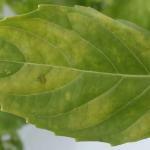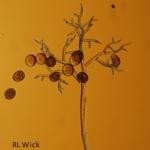Downy Mildew of Basil
Signs and Symptoms
Leaf yellowing is often the first symptom of basil downy mildew. Yellow areas are typically bordered by leaf veins. This may at first be mistaken for nutrient deficiency. When sporangia (spores) are produced, a characteristic fuzzy, dark gray to purple growth on the underside of the leaves is evident. Sporulation on the upper surfaces of leaves may also be seen in severe cases. The fuzzy growth of sporangia on the underside of the leaf may look as if soil had been splashed onto the leaf under-surface.
Disease Cycle
Sporangia are produced in darkness before sunrise. Sporulation occurs at 50-78°F and >85% relative humidity (RH). The pathogen requires at least 7 hours of darkness to produce sporangia. The sporangia are borne at the ends of tiny tree-like structures called sporangiophores which grow out of the stomata. The sporangia are dispersed by wind and splashing water. On wet leaves at temperatures from 41 to 83°F, sporangia germinate within 2 hours and infect plant tissue within 4 hours. Five to 10 days may elapse between infection and the appearance of symptoms; the duration of the latency period depends upon temperature and light exposure. Basil downy mildew is unable to survive winter temperatures in the northeastern US.
The pathogen is an obligate parasite, meaning that it cannot survive outside of a living host. It does not produce overwintering oospores but survives from year to year on living plants in places where basil production occurs year-round. From these sites the pathogen spreads via wind-dispersed sporangia that can travel great distances due to their dark pigmentation, which protects them from UV radiation. Although the downy mildew pathogen has been detected in basil seed, seed transmission is considered to be an uncommon event. Air-borne dissemination from infected plants is more likely.
Cultural Management
The most important environmental factors favoring disease development are high humidity and extended leaf wetness. These factors can be reduced by:
- Buy seed from a trusted source. Basil seeds are not amenable to hot water seed treatment as they produce a gelatinous exudate when in water, though some seed companies are starting to use steam seed treatment.
- Grow your own transplants and scout regularly for symptoms and signs. If you do buy transplants, inspect them carefully before purchasing and/or before bringing them into the greenhouse.
- Toward evening, heat and vent the greenhouse, especially when warm days are followed by cool nights.
- Improve horizontal air flow by the use of fans.
- Run fans at night. Fans may be connected to sensors that will turn them on when the RH reaches 70% and turn them off when it drops below 65%.
- Space plants in a way that allows good air circulation to facilitate drying of leaves.
- Water in the morning, if practical, or use drip irrigation rather than overhead.
- Expose plants to red light (λ 575-660 nm) at night to inhibit sporangia production in infected plants. Studies have shown that exposing plants to red light for a period of 10 minutes every few hours during the night can significantly reduce sporulation; however, the shading of leaves by other leaves negates this effect, so it is most effective when plants are smaller.
- Remove any symptomatic plants and dispose of them in the trash. Keep a trash bin with a lid close to you as you work to avoid carrying sporangia through the greenhouse.
- Grow tolerant or resistant cultivars. Classic Genovese types of basil are highly susceptible to downy mildew. ‘Eleonora’, ‘Everleaf’, “Tuscany’, and ‘Caesar’ are considered tolerant. Resistant cultivars include 'Amazel', 'Prospera', and the Rutgers series 'Devotion', 'Obsession', 'Passion', and 'Thunderstruck'.
Chemical Management
Some fungicides are labeled for herb transplants. There are differences in registrations for field grown plants versus greenhouse plants, so be sure to check the labels on individual products. Copper products, phosphites, cyazofamid, mandipropamid, oxathiapiprolin, and azoxystrobin are labeled for use on basil. Both conventional and organic products should be used in a preventative manner to protect plants from infection, as few have any curative properties. Consult the New England Vegetable Management Guide for a full listing of products.
It is the grower’s responsibility to read and follow label instructions. Be sure that a particular product is registered for use in your state. The label is the law and any recommendations made here are superseded by the label.


